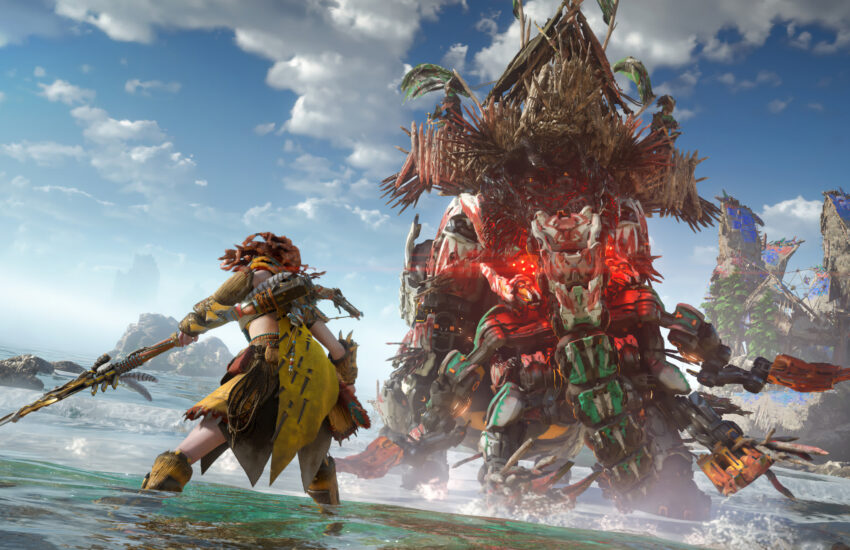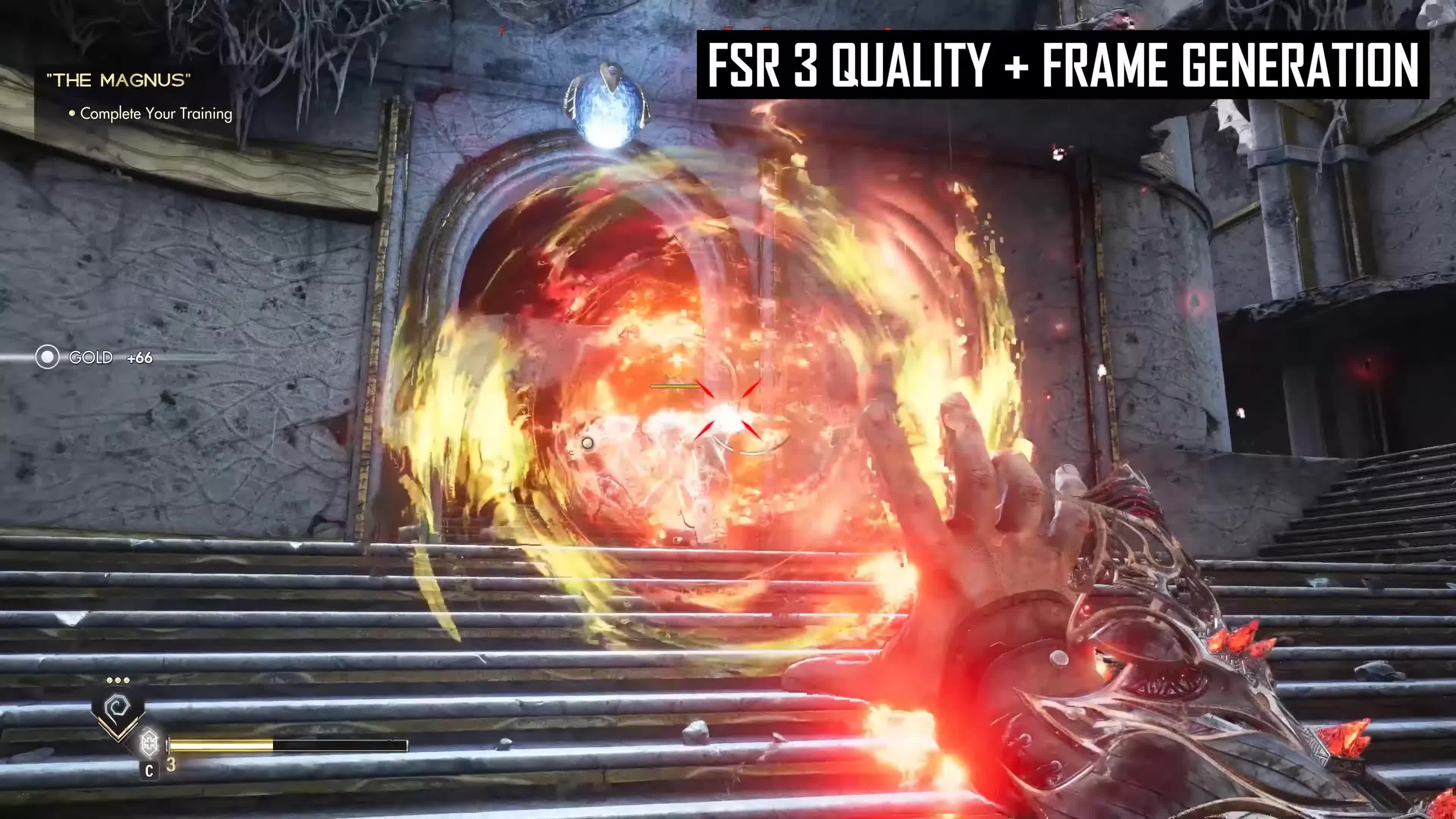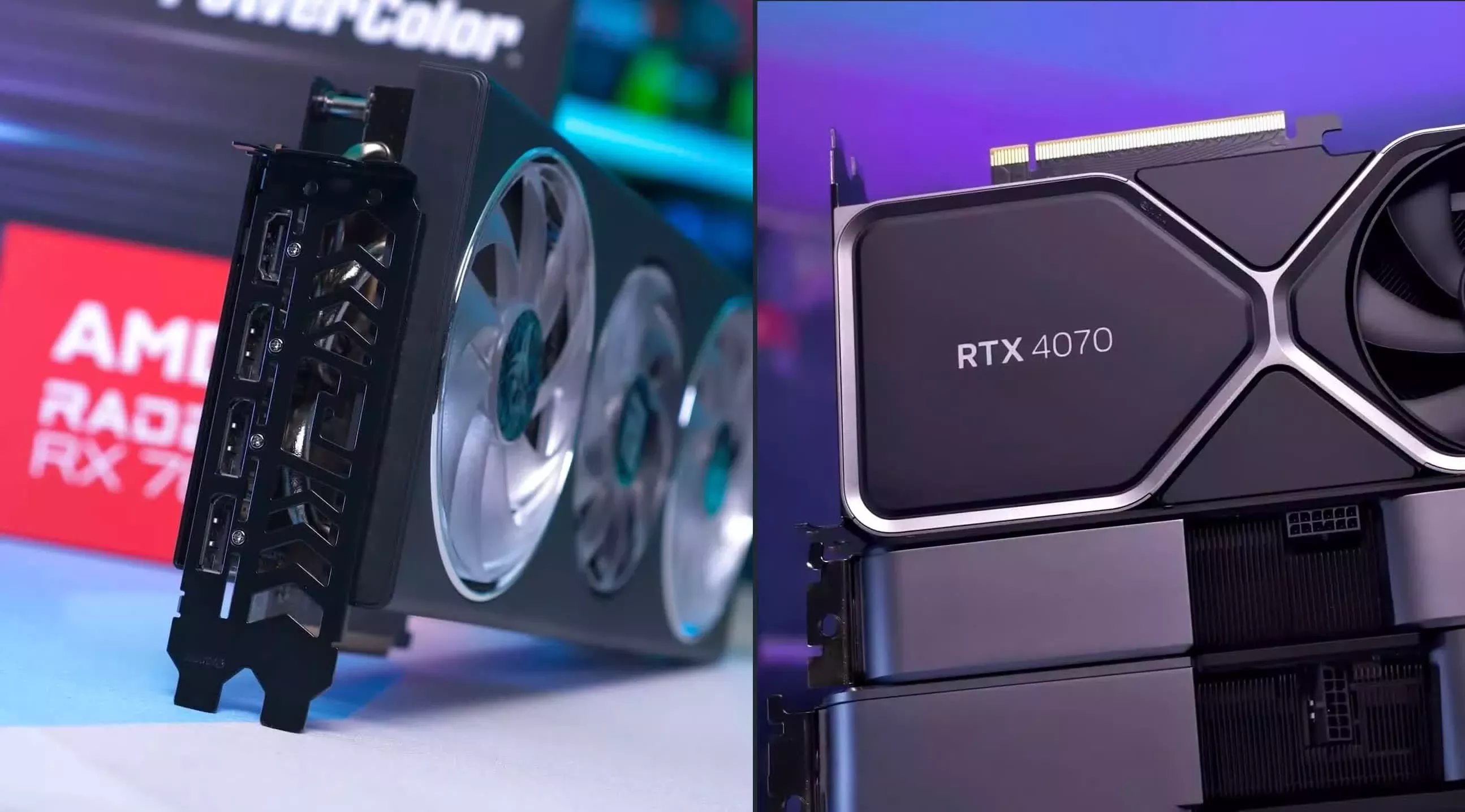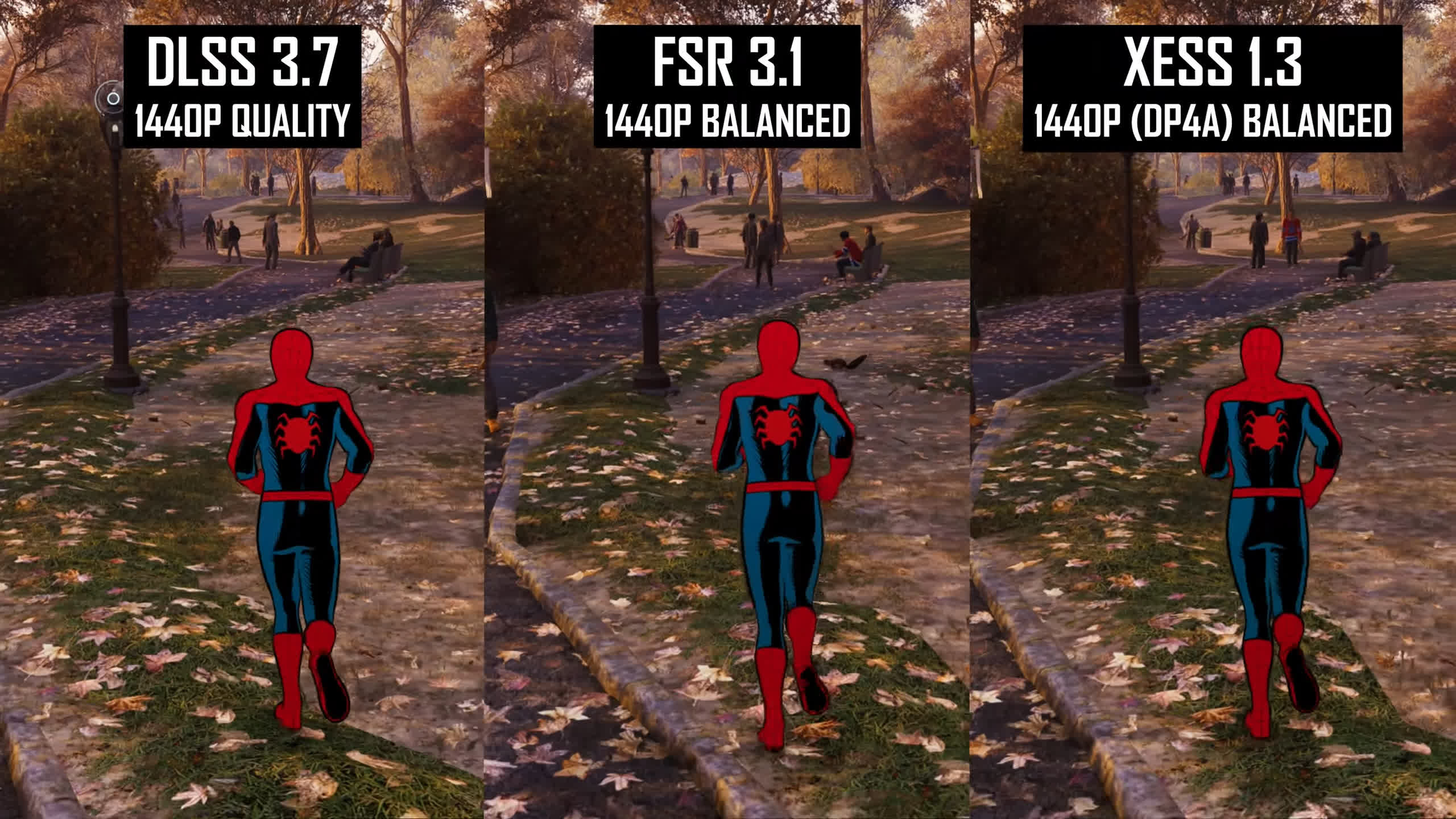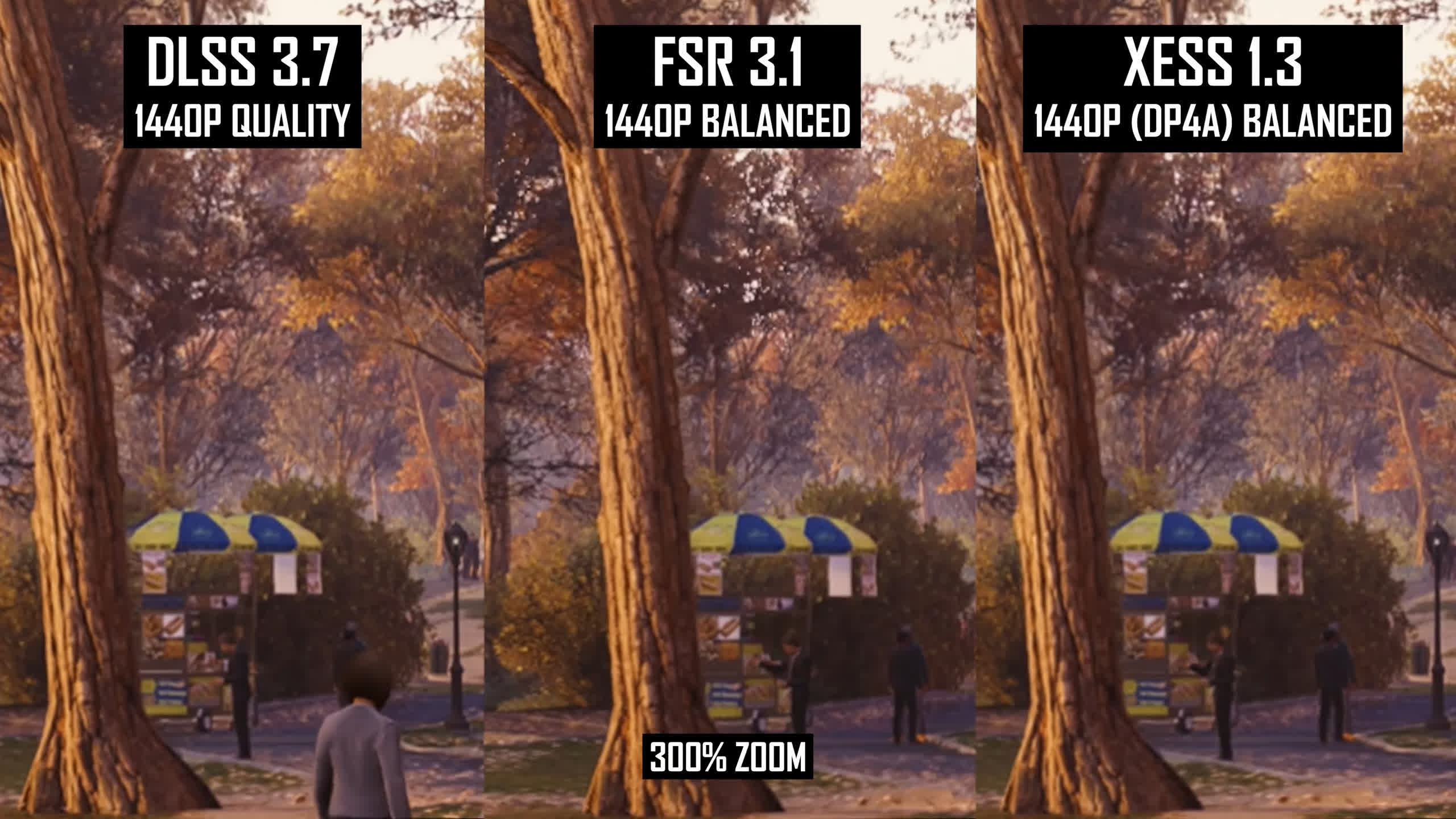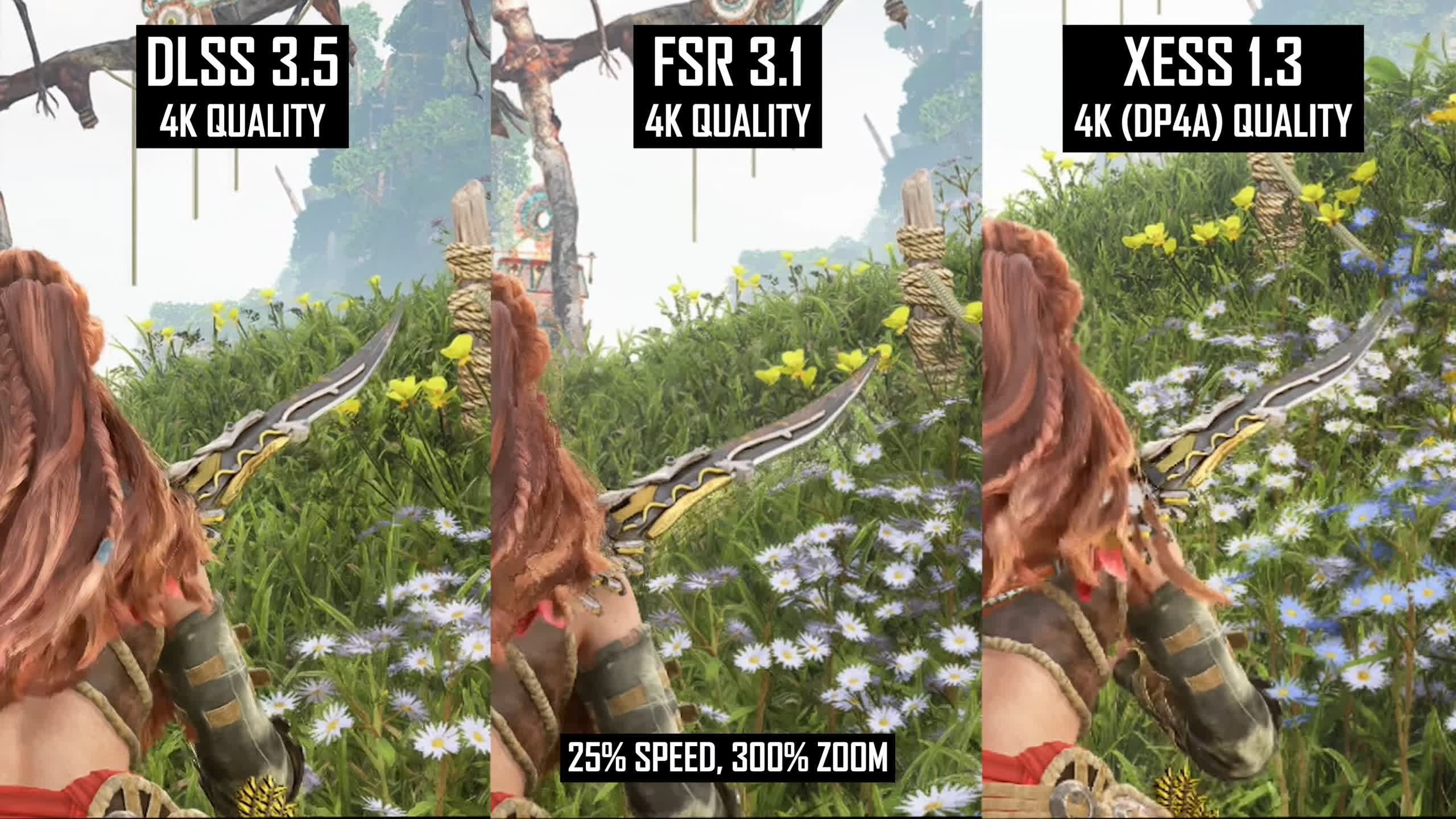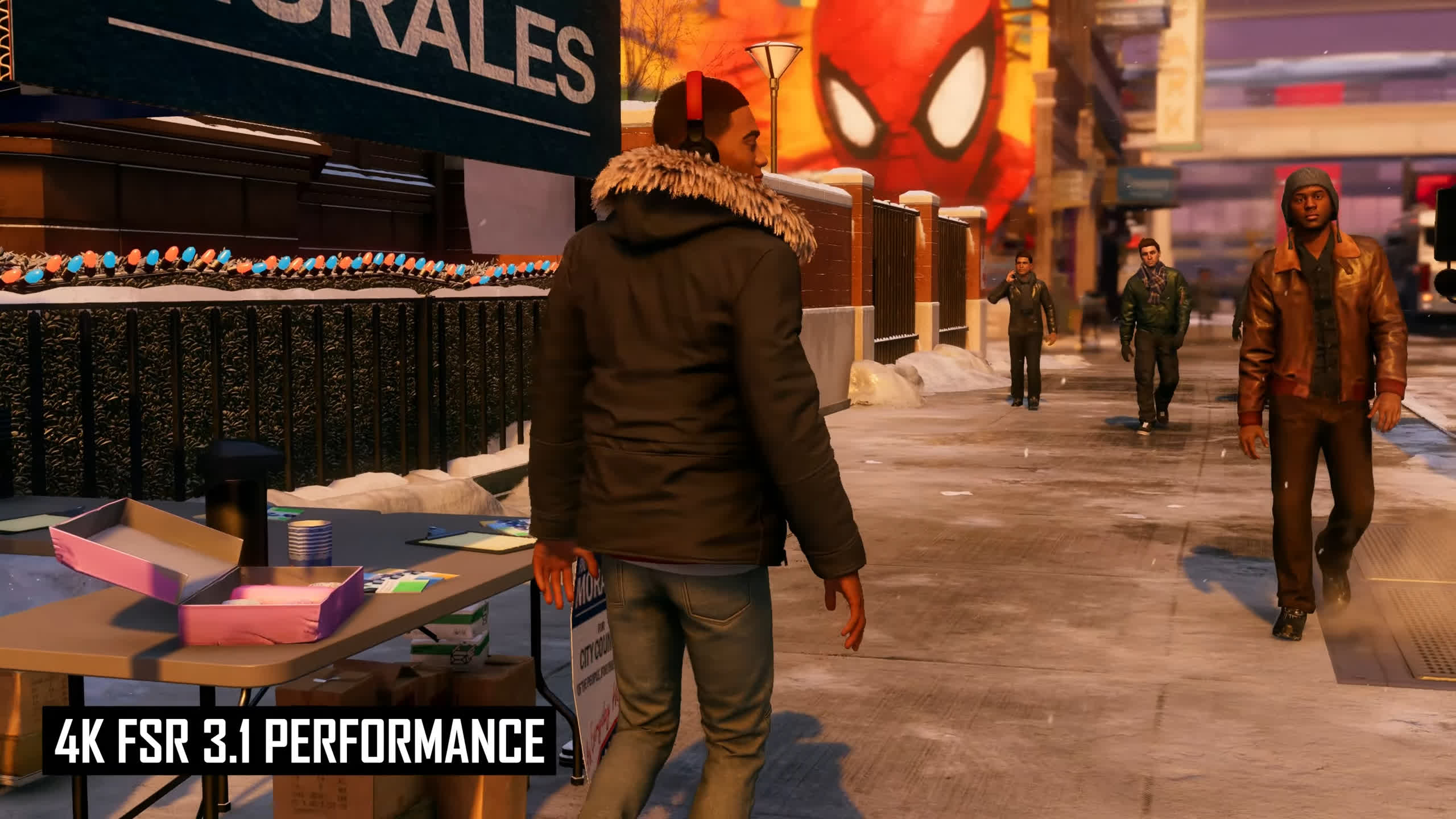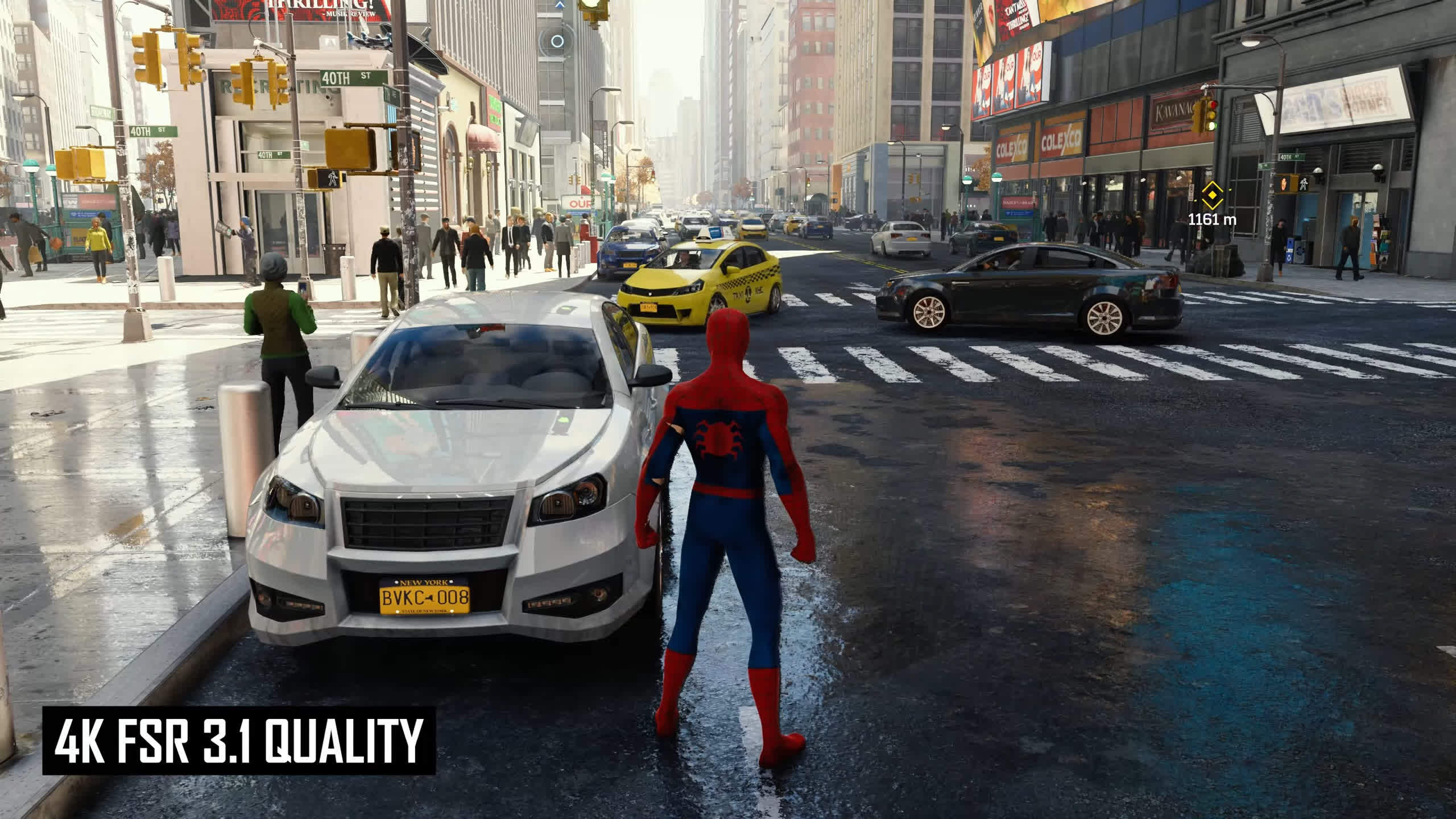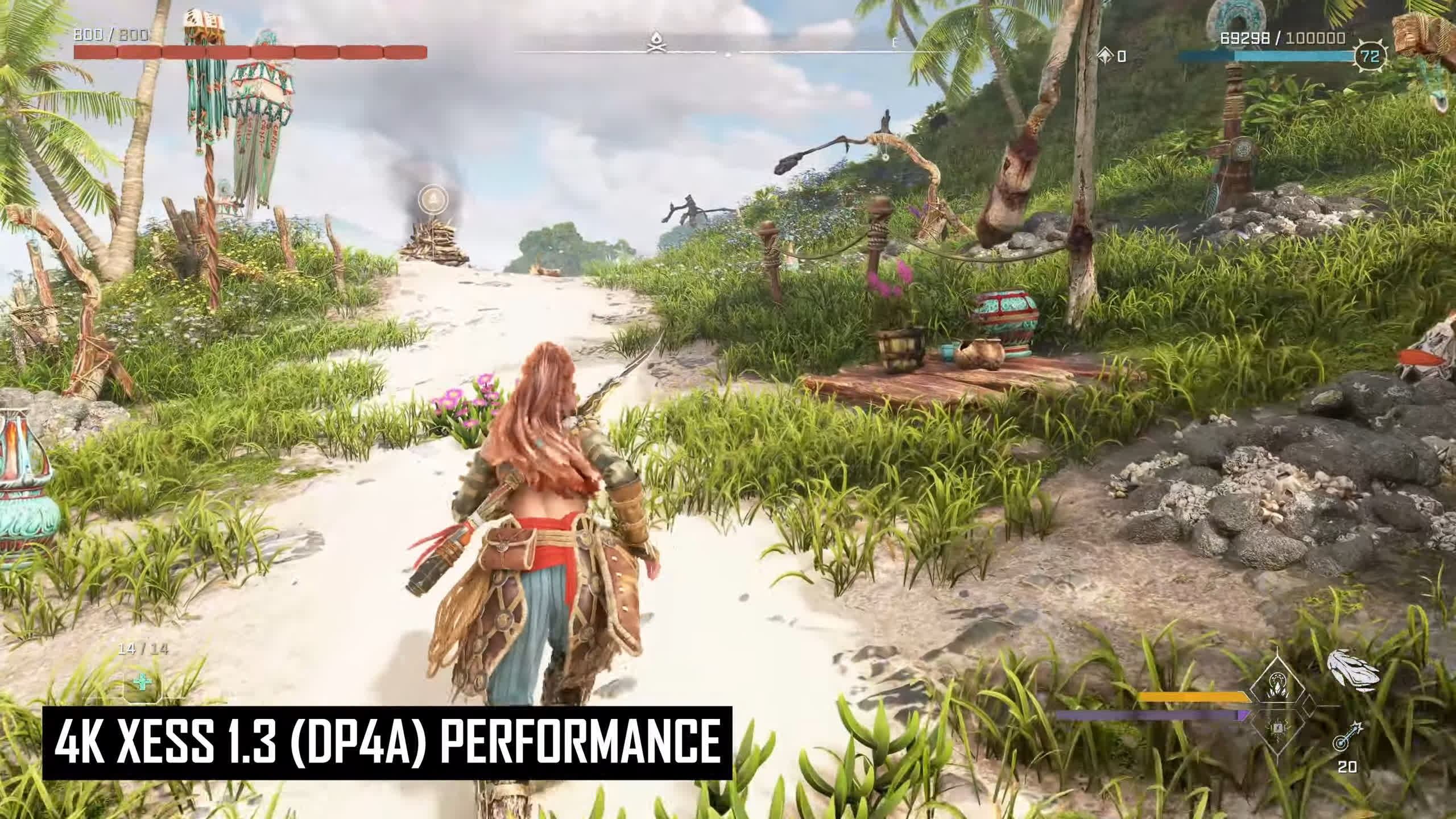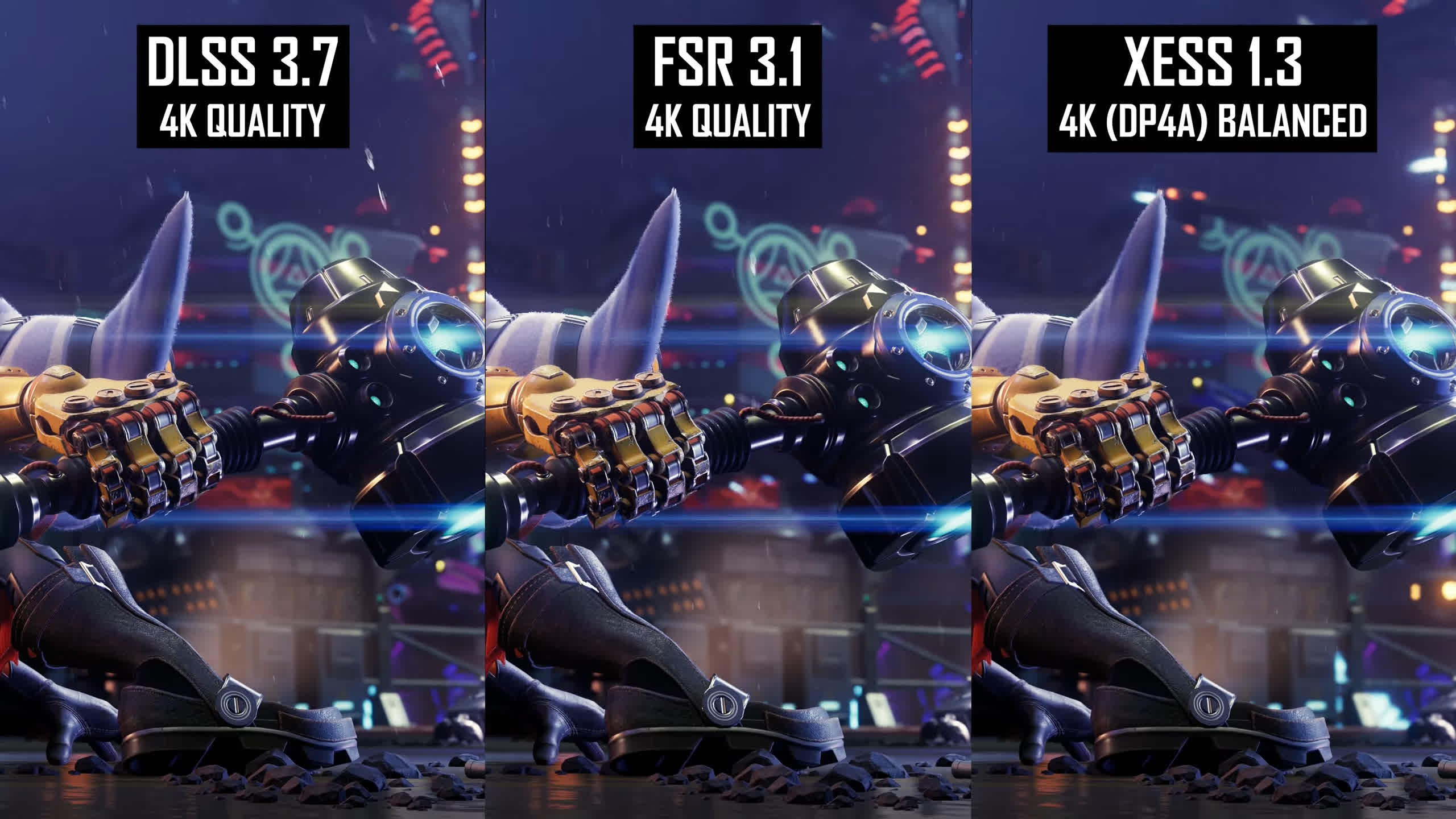Upscaling technologies continue to improve every year, and with AMD’s recently updated FSR 3.1 tech finally finding its way into some games, there’s no better time for a fresh image quality comparison. Today, we’ll be looking at all five games that have been updated to use FSR 3.1, along with the latest and greatest upscalers from Nvidia and Intel in the form of DLSS 3.7 and XeSS 1.3.
With everything up to date and officially integrated into games, this should give us the best comparison between the technologies.
When AMD announced FSR 3.1, they promised several improvements to the upscaling component, such as improved temporal stability for reduced flickering and shimmering, enhanced ghosting reduction, and better detail preservation. With previous versions, such as FSR 2.2 and the initial release of FSR 3.0, AMD’s upscaler was generally the worst for temporal stability, so these are very welcome changes.
In addition to improvements to the upscaler, AMD also decoupled frame generation from FSR, allowing users to now utilize AMD’s frame generation tech with DLSS or XeSS, or even native resolution. Furthermore, they are now bundling FSR into a DLL file that ships with games, theoretically providing the same “DLL swap” advantages as DLSS and XeSS when those technologies receive updates.
No more waiting for developers to upgrade the tech themselves – gamers should just be able to swap the DLL to a newer version. However, the focus of this review is specifically on FSR 3.1 upscaling.
Performance Testing
To properly assess the image quality of each upscaler, we first need to normalize performance. That is, find out how each setting performs and match up the relevant settings that deliver the same performance uplift. This prevents any upscaler from abusing the naming scheme and allows more efficient algorithms to gain a fair advantage.
To do this, we are testing on the Nvidia GeForce RTX 4070 and the AMD Radeon RX 7800 XT, two similarly matched graphics cards that benefit from upscaling, both slotted into our AMD Ryzen 7 7800X3D test system with 32GB of DDR5-6000 CL30 memory.
Starting with Ratchet & Clank: Rift Apart benchmarked at 4K using Very High settings with no ray tracing, we find that on the RTX 4070, DLSS and XeSS deliver a similar performance uplift using the Quality mode.
This is because Intel recently renamed each of their presets to more closely match DLSS in performance, increasing the scale factor in the Quality mode from 1.5x to 1.7x, which was previously labeled Balanced. This means that DLSS Quality is actually rendering at a higher base resolution than XeSS for a similar level of final performance.
Meanwhile, FSR isn’t as effective, only providing 90 FPS instead of the 96 FPS seen with DLSS using the Quality mode. This means that in this title, FSR Balanced sits between DLSS Quality and Balanced in final performance on an Nvidia GPU.
However, when testing on an AMD GPU, things are a little different. In this title, relative to native TAA, FSR Quality is able to provide a 45% performance improvement, very similar to the 43% uplift seen on the RTX 4070 for DLSS Quality. This suggests FSR is a little more effective on an AMD GPU and is able to provide a similar performance uplift for AMD owners as Nvidia provides with DLSS to GeForce owners. On the other hand, XeSS is less effective on RDNA3, with the Balanced preset matching FSR Quality in performance.
Therefore, when comparing the image quality in Ratchet & Clank, we feel the best matchup is DLSS Quality vs. FSR Quality vs. XeSS Balanced.
What we are looking for are the settings on an AMD GPU that match the performance uplift of DLSS Quality on an Nvidia GPU, because those configurations are the most likely to be used. Nvidia owners are most likely to stick to DLSS, and AMD owners will be choosing between FSR and XeSS. We will use the same sort of decision-making for the rest of the comparisons because showing every single possible combination would take up a ridiculous amount of time.
In Horizon Forbidden West, we’ve tested using Very High settings, and on the RTX 4070, you’ll probably want to use upscaling at 4K. This title is a little different from Rift Apart in that the Quality mode for all of DLSS, FSR, and XeSS provides a similar performance uplift on an Nvidia GPU, and that’s also true of the other modes. We should also note that this is the only game of the five tested to use DLSS 3.5.10 instead of the newer DLSS 3.7 revision.
However, on the RX 7800 XT, FSR isn’t as performant. While FSR Quality delivers 65 FPS in our benchmark pass, similar to the 63 FPS from DLSS Quality on the RTX 4070, the base TAA frame rate on the Radeon card is higher.
So, FSR Quality is only delivering 30% more performance here, compared to 35% more performance on the Nvidia card in this game. This means that if Radeon owners want to match the uplift that DLSS Quality provides on an Nvidia card, they’ll have to use either the FSR Balanced mode or XeSS Performance because XeSS is very taxing on RDNA3 in this title.
In Ghost of Tsushima, we tested using max settings at 4K, and again, upscaling is strongly advised on this level of GPU. On the RTX 4070, the results seen are very similar to Ratchet & Clank, with DLSS Quality and XeSS Quality delivering a similar 41% performance improvement. However, the closest matchup from FSR is the Balanced setting, not the Quality setting.
On the Radeon card, FSR Quality doesn’t provide quite as much of an uplift as DLSS Quality on GeForce, but it gets the closest at a 36% gain. XeSS doesn’t fare too badly in this title, with the Quality mode matching FSR Quality for performance, while the Balanced mode delivers a similar uplift to DLSS Quality on GeForce. We could go either way here, but let’s compare FSR Quality and XeSS Quality as they deliver similar performance on the Radeon card.
In Spider-Man Remastered, we tested using 4K max settings with maximum ray tracing. On the RTX 4070, DLSS Quality is in the lead here, delivering a 52% uplift in frame rate over native TAA rendering. Both FSR and XeSS aren’t as effective, with the Balanced mode for each delivering the closest level of performance.
To achieve a similar level of performance gain on the RX 7800 XT as DLSS Quality, we had to use either FSR Balanced or XeSS Balanced. We could even justify XeSS Performance here, as its 50% uplift is also similar to what DLSS Quality provided on the 4070, but we’ll stick to Balanced versus Balanced given how similar performance is on the Radeon GPU, which is most relevant.
Then we get to Spider-Man: Miles Morales, tested first at 4K using the Very High preset without ray tracing. On the RTX 4070, the resulting performance is very similar to what we’ve seen previously.
DLSS Quality and XeSS Quality both deliver about a 40% to 45% uplift, while the uplift from FSR Quality is lower at just 33%. This means the FSR Balanced setting is a little closer in its overall performance.
On RDNA 3, the uplift from using FSR Quality is pretty similar to the same setting on the GeForce card, a 31% gain versus a 33% gain. This again means that to achieve a similar uplift as DLSS Quality on the GeForce card, we need to drop the settings to FSR Balanced and, unfortunately for Intel’s technology, XeSS Performance mode.
What we did find interesting though is that these matchups can vary depending on the other settings used in the game. For example, just out of curiosity, we enabled ray tracing in Miles Morales and retested. Now, each of the settings is more comparable on a name basis.
On the GeForce GPU, all three techniques using the Quality mode deliver the closest performance. And to achieve a similar performance uplift on the Radeon card, again, the Quality settings make the most sense. The quality comparisons we ultimately got are without ray tracing, though, as we feel those settings are more realistic on this tier of GPU.
To summarize the performance section, the results from each upscaler are quite variable and depend on the game, graphics card, and even the settings used. The actual setting labels, e.g., Quality or Performance, also no longer refer to the same render resolution across the three techniques. So choosing the most appropriate matchup needs to be done on a per-game basis, and this is what you will find in games as well: in some titles, FSR will perform better than others, while in a different set of games, XeSS might outperform the norm.
Ultimately, this is what we’ve settled on for the main comparisons, with the goal of achieving a similar performance gain from FSR and XeSS on a Radeon card as we achieved using DLSS on a GeForce card. Typically, for FSR, this meant the Balanced mode, occasionally Quality; while for XeSS, it usually meant either Balanced or Performance.
DLSS with the latest 3.7 revision appears to be a little more efficient than FSR, something that wasn’t the typical case before, though this could be due to the game selection we’ve used. The XeSS DP4a pathway is definitely faster on Ada Lovelace, though it struggles a bit on RDNA3, so GeForce gamers using XeSS will typically achieve results more comparable to DLSS.
FSR 3.1 vs FSR 2.2
Moving now into image quality, the first thing to assess is whether FSR 3.1 is actually an improvement over FSR 2.2. Luckily, we have some old footage of Ratchet & Clank: Rift Apart that is going to come in handy for comparisons. Ratchet is one of the worst examples of FSR 2.2, as it has a large number of issues, so it presents a great opportunity to see where AMD has improved.
For a better representation of image quality comparisons, check out the HUB video below:

Looking at the 4K Quality mode, it’s pretty apparent early on that FSR 3.1 is generally an improvement. There’s less blockiness, less pixelation, and better image stability in the newer revision compared to FSR 2.2, even at the highest resolution. See the poles on the left side (video above): if we pause this in-motion example and zoom in, you’ll immediately see the reduction in artifacts in FSR 3.1, which applies across most of the image. You’ll see less shimmering as we walk across the metal surface on the ground.
In the next video example, the hexagonal grid pattern on the ground is a lot more stable in FSR 3.1 to the point where it’s not as distracting. The same can be said for the background float in the following example. While shimmering is not fully eliminated and there’s clearly a sharpness pass difference between the footage we captured, the amount of shimmering is reduced in the newer FSR version.
The differences are more pronounced using the FSR Performance preset, which upscales from 1080p to 4K. Lower render resolutions were a common pain point for FSR 2.2, with lots of pixelation artifacts in motion and heaps of stability issues. With FSR 3.1, we would say this has been significantly improved.
The main downside we’ve noticed to FSR 3.1 so far is increased ghosting relative to FSR 2.2 in situations where there was already ghosting. This is despite AMD claiming FSR 3.1 brings “enhanced ghosting reduction.”
Image Quality Comparison: Ratchet and Clank
Let’s now compare FSR 3.1 to DLSS 3.7 and XeSS 1.3 in this title. Using equivalent performance settings, it’s clear that DLSS provides the best experience, though that’s hardly a surprise as previous investigations also found DLSS to be superior in Rift Apart. DLSS has the cleanest presentation, the best fine detail reconstruction, and the least artifacts in motion.
For a better representation of image quality comparisons, check out the HUB video below:

FSR 3.1 has noticeable issues with ghosting in this game, even when using the Quality mode. Neither DLSS nor XeSS using the Balanced DP4a path had significant ghosting concerns, but with FSR 3.1, it’s obvious at times during gameplay.
One of the issues we’ve pointed out with FSR previously is how it handles translucent or transparent objects, and that’s still the case with version 3.1. DLSS is far superior at reconstructing this holographic circle, while XeSS does a reasonable job. FSR is the blurriest and least distinguishable.
With that said, FSR does fare better than XeSS at times for edge clarity and fine detail, for example, when looking at the flagged ropes and architectural elements, XeSS has visibly jagged edges, whereas FSR and DLSS look similar in this area. However, in other areas, especially for background objects in this scene, XeSS has fewer disocclusion artifacts and sizzled edges than FSR, with DLSS typically in the leading position.
Some of this could probably be classed as nitpicking, because there were significant stretches of the game where it was difficult to tell the differences between the three techniques. Especially in cutscenes with close-up objects and depth of field blur, many of the problems with upscaling fine details are hidden. We do believe FSR 3.1 is closer to DLSS than FSR 2.2, but with ghosting being probably the most obvious artifact across all the techniques, it’s still not as good.
Image Quality Comparison: Horizon Forbidden West
Next up is Horizon Forbidden West, and we wanted to start by looking at water. Even when not walking around, you can’t escape a flowing river, which brings up some artifacts in motion. DLSS Quality mode is clearly the best here, but there are issues with the performance-normalized FSR Balanced and XeSS Performance modes.
For a better representation of image quality comparisons, check out the HUB video below:

With FSR 3.1, we see weird pixelation and garbling effects on the surface of the water, while with XeSS 1.3, we get low-resolution surface reflections likely due to the Performance mode’s very low render resolution. When zoomed in, you’ll probably see those artifacts more closely.
In general play, though, we were quite impressed with the image quality of FSR 3.1 given the foliage-dense environments and third-person perspective. For example, it’s hard to spot any quality difference between Aloy’s flowing hair across the various techniques, and while DLSS is superior if you pause and look closely, in actual gameplay this area in motion looks perfectly fine with FSR – something you can’t always say about hair in other FSR titles.
Another area where FSR held up well is grass. FSR gets close enough to DLSS in motion that you can’t really notice much of a difference, and even when pausing, DLSS is only slightly superior. In contrast, XeSS Performance mode looks absolutely terrible and really struggles with foliage elements, presenting jagged edges and a lot of pixelation. This pretty much makes XeSS a non-starter in this game, as the image quality isn’t good enough and on AMD GPUs it performs notably worse than FSR.
The main issue with FSR, and also an issue with XeSS, is disocclusion artifacts, still a pain point for FSR 3.1 relative to DLSS. When Aloy is moving around and the background is filled with dense details – pretty common in the world of Forbidden West – the edges of Aloy herself, her weapon, and parts of the background suffer.
There’s low edge quality, sizzling, and loss of detail in these areas, which is pretty noticeable in motion and far less problematic with DLSS. Even XeSS handles this better than FSR, though the Performance mode is generally of far lower quality to the point of not being usable.
FSR just seems to lack the algorithms and models to determine what is “good” information to retain between frames and what needs to be replaced, relative to the other techniques that are AI-enhanced. With that said, this is far from the worst example of disocclusion artifacts we’ve seen from FSR, and we’d actually say this looks better with FSR 3.1.
We also spotted ghosting in Horizon with FSR 3.1, though to a lesser extent than with Rift Apart, so that’s also a bit problematic here. With all of that said, on an AMD GPU we would definitely choose to use FSR 3.1 over XeSS 1.3 at the same levels of performance; it’s just that FSR 3.1 still isn’t quite at the level of DLSS.
Image Quality Comparison: Ghost of Tsushima
Next up is Ghost of Tsushima. In the static but windy scene shown in the video above, there aren’t huge differences between the three techniques, helped by good performance which means that we can use the Quality setting for all. DLSS and XeSS do the best job of preserving the finest details, while FSR is a little grainy at times. The XeSS presentation is also the softest and has a small amount of foliage shimmer in the distant trees. Any of these techniques looks very usable here.
For a better representation of image quality comparisons, check out the HUB video below:

We were also impressed with how FSR held up in the walking example: the fur coat on the character’s back, the foliage in the background, and other leaf textures around the environment all look very similar to DLSS. With XeSS, there is notable foliage shimmer, especially when looking closely. FSR also suffers from some disocclusion artifacting that you don’t get with DLSS, though this is harder to spot than in Horizon Forbidden West.
Not everything is perfect with FSR 3.1, as these disocclusion artifacts become more noticeable in tricky scenarios, especially in combat. This can be combined with ghosting at times, even using FSR Quality, which again is not visible with DLSS or XeSS.
While it’s definitely visible at normal speed, it should be made more obvious in the sample video above around the sword when slowed down, even accounting for differences in the background – though still in general an improvement on previous FSR versions.
Image Quality Comparison: Spider-Man Miles Morales
Next up is Spider-Man Miles Morales. First, we see a quick comparison of a transparent object in this game, similar to what we saw earlier with Rift Apart. In both examples, the FSR image is a bit garbled compared to DLSS and XeSS, although not to the point where FSR is unusable. DLSS also has the best fine detail reconstruction for some of the thin tree branches.
For a better representation of image quality comparisons, check out the HUB video below:

When swinging around the city, DLSS generally has the best image stability, followed by FSR and XeSS at a similar level. DLSS can render at a higher resolution to deliver a similar level of performance, which helps reconstruct fine detail like branches and the sides of buildings. While FSR 3.1 doesn’t look awful here, it is a step behind DLSS.
In the opening cutscene, the order of render resolution again determines the quality.
DLSS provides the cleanest image with the best stability and detail, followed by FSR, with XeSS in last place. The Performance mode for Intel’s solution doesn’t hold up for the finest details like the fur on the coat and other distinct lines, with the high performance requirements on AMD GPUs to run the DP4 path leading to lower quality at the same performance output. FSR 3.1 is certainly playable, but not at the same level as DLSS.
Image Quality Comparison: Spider-Man
Lastly, let’s look at Spider-Man Remastered, which is similar to Miles Morales. Like most of the other games we’ve examined, FSR 3.1 has some ghosting issues in this title, though DLSS does as well, albeit to a lesser extent. XeSS has no visible ghosting, even in Balanced mode. Some elements and types of motion don’t play nicely with the tweaks AMD has made to FSR 3.1.
For a better representation of image quality comparisons, check out the HUB video below:

DLSS clearly has the best image stability, with little to no shimmering in foliage and other textures. FSR 3.1 has noticeable problems with some of the tree details in this game, as does XeSS, although I would generally give a slight edge to Intel’s technique.
Similarly, there are more flickering and stability issues with ground textures in the FSR 3.1 image compared to XeSS and especially DLSS, though this isn’t as problematic as in previous FSR iterations.
1440p Image Quality Comparisons
We’ll round out this review with a couple of additional investigations, starting with image quality at 1440p. Previously, FSR has struggled as the final output resolution decreases, with the visual quality at 1440p looking worse than at 4K. Is that still the case with FSR 3.1?
Below is the Ghost of Tsushima wind example, now using 1440p Quality upscaling across the board. At 4K, DLSS did look a little better than FSR, but not substantially so. At 1440p, FSR falls behind relative to DLSS, similar to what we’ve found before. The technology here is more pixelated and has more jaggies than DLSS. That said, we wouldn’t call the XeSS image better than FSR. While parts of it do appear to have more detail, the image is both very soft and grainy in some areas.
For a better representation of image quality comparisons, check out the HUB video below:

Looking at the portal sequence in Ratchet & Clank at 1440p, FSR doesn’t hold up as well as at 4K relative to DLSS, with even the XeSS Balanced mode delivering a more stable image. Particularly when you look closely at background details, there’s still noticeable shimmering in the FSR 3.1 presentation, while DLSS is relatively clean. XeSS sits somewhere between the two and would be my preferred way to play this title.
In Spider-Man Remastered, it’s a similar situation. Any shimmering artifacts and issues with detail reconstruction are still worsened when using FSR at 1440p.
In this particular example, we’re still seeing ghosting, and XeSS delivers less shimmering despite rendering at a lower resolution before upscaling. XeSS isn’t perfect, though; DLSS still delivers clearly superior image quality, but it holds up reasonably well.
Quality vs Quality vs Quality
We also wanted to explore a couple of scenarios where all image upscalers were set to the same named quality mode, representing a hypothetical situation where all upscalers at the same mode deliver the same performance.
To be clear, this is not the case, but it would show where things lie if AMD and Intel could improve the performance of their techniques without impacting visuals.
Let’s return to the Spider-Man example to examine ghosting. What we found, comparing at the 4K Quality mode for all, is that using a smaller upscale factor doesn’t seem to impact the level of ghosting in FSR all that much – it’s still there using higher quality settings. The foliage shimmering is also present, so even if we compared FSR to DLSS using the same mode previously, we’d come to a very similar conclusion.
Very similar results appear when comparing all using their Performance modes. Ghosting is still quite problematic in the FSR image, and shimmering has regressed to the point where AMD’s solution is clearly the worst. Even XeSS using the Performance mode, which actually renders at a lower resolution, has less shimmering. DLSS is usable to a degree in this configuration even though there is detail loss in motion, whereas we wouldn’t really say the same for FSR 3.1.
For a better representation of image quality comparisons, check out the HUB video below:

Here’s the water example from Horizon Forbidden West, but now run using the Quality modes for all configurations. While this does improve the quality of the FSR and XeSS presentations notably, it doesn’t resolve some of the FSR surface artifacts on the water, which are still there even using the highest quality mode at 4K. XeSS is notably improved, though, with a much higher resolution appearance to the water and is now able to deliver superior results to FSR – if only it ran at the same level.
We’ll also show moving around in Horizon, which is a much better showing for XeSS in particular when everything is set to the Quality mode. FSR 3.1 also holds up nicely here when the quality is bumped from Balanced to Quality. However, there are still visible disocclusion artifacts with FSR that you don’t get with DLSS, with lesser artifacts seen in the XeSS image.
XeSS also struggles badly with some detail reconstruction and shimmering for distant objects. We think FSR 3.1 is usable in this title, but DLSS is the better upscaler without a doubt.
For a better representation of image quality comparisons, check out the HUB video below:

Lastly, a comparison in Ratchet & Clank with everything using the Performance mode. Not much new to say here – DLSS is still the king of upscaling from lower render resolutions, while FSR struggles relative to what we see using the Quality mode.
FSR 3.1 isn’t a disaster for shimmering or blockiness in this configuration; it’s a huge step up relative to the previous version for sure, but it’s still behind DLSS and not at the level it needs to be to get a recommendation.
What We Learned
With all of that testing and comparisons now complete, we can begin to answer some of the burning questions about FSR 3.1 and how it performs.
Is FSR 3.1 a genuine improvement over FSR 2.2?
Based on what we’ve seen so far across some limited comparisons and previous FSR footage, we’d say that it is. Some of the most problematic artifacts – primarily shimmering, sizzling, and detail in motion – are improved in this latest version and are now less noticeable.
FSR 3.1 doesn’t completely eliminate the stability concerns we’ve brought up with FSR over the years, but it does make them less noticeable.
Low render resolution upscaling, like using the Performance mode, has also received substantial improvements. Games like Ratchet & Clank, which looked terrible using the FSR Performance mode before, are now noticeably improved – though you can still tell you’re using the Performance mode rather than Quality.
Lower output resolutions like 1440p seem better but still deliver mixed results.
Unfortunately, there is a trade-off here, and that’s ghosting. Across the five games we looked at, all five had issues with ghosting in some fast motion scenarios, particularly against detailed backgrounds.
These five games did use three separate game engines and come from three different developers, although one company – Nixxes – was responsible for their ports. It’s possible this is an issue with Nixxes’ implementation of FSR 3.1, but comparing the same title with FSR 2.2 and FSR 3.1 showed FSR 3.1 to have worse ghosting, which was not expected.
As things stand with the available evidence, this appears to be a regression in the technology and is perhaps how they’ve achieved greater stability – AMD might simply be using more temporal samples, which puts the image at greater risk of ghosting. A few more game examples from different developers will confirm whether that’s a broad issue with FSR 3.1.
Which upscaler should AMD GPU owners use: FSR 3.1 or XeSS 1.3?
This varies depending on the game. XeSS typically performs worse than FSR on AMD GPUs at the same quality preset and worse than XeSS on Nvidia GPUs, which means that in some titles you have to use low-quality modes to achieve a similar level of performance as FSR.
In games like Horizon Forbidden West, that makes it hard to justify using XeSS when the quality at performance-normalized settings is notably worse. In other games, it can depend on what artifacts you want to tolerate.
In Ghost of Tsushima, FSR has better image stability and sharpness at times, but more ghosting and disocclusion artifacts. In Ratchet & Clank, using XeSS eliminates ghosting and can produce better stability but comes at the cost of some jaggies and low-resolution artifacts. In the Spider-Man games, XeSS also eliminates ghosting and can improve foliage reconstruction, at the cost of detail.
With ghosting being an especially noticeable artifact – at least to our eyes – there are still games where we would prefer to play using XeSS over FSR 3.1, and judging by some brief examples, this holds truer at lower output resolutions like 1440p. So it’s an improvement on previous versions of FSR but not necessarily a win compared to XeSS.
DLSS vs. FSR vs. XeSS, where do they stand using the latest versions?
Across these five games, DLSS is universally better, with version 3.7 continuing to improve upon the technology. Compared to earlier versions of DLSS, there are simply fewer artifacts now, and Nvidia continues to evolve the technology as their competitors attempt to catch up. This means that GeForce owners are still getting access to the best upscaling solution that produces the best image quality.
FSR 3.1 is still noticeably behind DLSS, and we didn’t expect a single update to completely close the gap. But the gap has been narrowed somewhat with the improved image quality we’re seeing in this revision. Before, there have been situations where FSR simply isn’t usable in some games, especially when using presets below 4K Quality. With FSR 3.1, you’re less likely to encounter configurations that deliver poor image quality filled with shimmering, but there are still issues around lower render resolutions and, now, ghosting.
Where the ecosystem has improved as a whole, especially for those with non-GeForce GPUs, is the tag team effort of FSR and XeSS. While we wouldn’t always recommend FSR and don’t think it’s usable in every configuration, there are scenarios where XeSS DP4a is usable and easy to recommend – not at the level of DLSS, but usable enough for an enjoyable gaming experience.
In the five games tested today, if you run the best option out of XeSS or FSR on a Radeon GPU, you’re getting a pretty good experience. That wasn’t the case a couple of years ago.
On top of that, there are more reasons than ever for game developers to integrate all three technologies. DLSS is king for GeForce owners and offers the best overall quality. XeSS provides decent upscaling quality for those who don’t have a GeForce RTX GPU. And FSR 3 provides decoupled frame generation for those without a GeForce 40 series GPU, plus the upscaler might work okay. All triple-A game releases should be integrating all three technologies.
And while the upscaling ecosystem has kept improving and FSR 3.1 is a step in the right direction, AMD should absolutely not take this as a final victory. AMD’s upscaler is still inferior to DLSS and needs continual work to remain a competitive option. If AMD wants to convince prospective GPU buyers that Radeon cards are worth as much as GeForce cards, their upscaler needs to be just as good as DLSS. We’re still waiting for that to happen, and until it does, we won’t be able to recommend Radeon without a discount.

